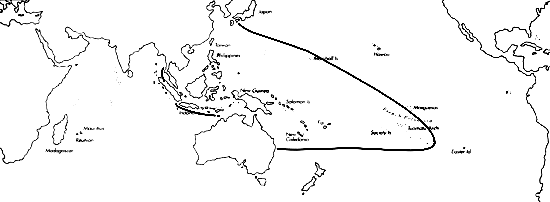
Skip Navigation Links
View access keys for this site.

Range: W. and Central Pacific, except for Hawaii and Marquesas; W. Thailand and Java.
Description: Moderately small to medium sized, moderately light to moderately solid. Last whorl ventricosely conical to broadly and ventricosely conical; occasionally ovate; outline convex at adapical third, almost straight below; left side slightly concave near base. Shoulder subangulate to rounded, sometimes nearly indistinct. Spire of moderate height, outline almost straight to slightly convex. Maximum diameter of larval shell about 0.65 mm. First 5 postnuclear whorls tuberculate. Teleoconch sutural ramps slightly convex, with 0-1 increasing to 3-4 spiral grooves, gradually finer and inconspicuous in later whorls. Last whorl with fine closely spaced, mostly granulose spiral ribs from base to shoulder.
| Shell Morphometry | ||
|---|---|---|
| L | 28-51 mm | |
| RW | 0.13-0.30 g/mm | |
| (L 33-45 mm) | ||
| RD | 0.62-0.72 | |
| PMD | 0.71-0.85 | |
| RSH | 0.13-0.22 | |
Ground colour white, often suffused with pale violet. Last whorl with 2 solid or interrupted brown spiral bands, intermittently connected by axial markings. Occasionally entire last whorl overlaid with brown except for a spiral row of white areas at centre or below shoulder. Base violet. Larval shell and about first 4 postnuclear sutural ramps pink. Following sutural ramps matsching last whorl in colour pattern. Aperture violet with a pale band at centre, bluish white in larger specimens.
Periostracum yellow to yellowish brown, moderately translucent and smooth (New Caledonia; Estival, 1981) or ridged and finely tufted (Fiji and Papua New Guinea; Cernohorsky, 1964; Chaberman, 1981); in the Marshall Islands, periostracum variably thick, translucent to opaque, with well-separate spiral rows of long bristles on last whorl and spire (Pearson, pers. comm., 1989, unpubl. observ.).
In Marshall Is., foot flesh-coloured and spotted with white, dorsum dark red anteriorly and white posteriorly. Siphon dark brown mottled with reddish brown (Pearson, unpubl. observ.)(Pl. 83, First row, right). In N. Papua New Guinea, dorsum of foot light red dotted with white, solid red at its extremities. Sole light red, brighter at both ends. Rostrum red dotted with black. Tentacles red tipped with black. Siphon red with white and black dots (Pl. 76, Fig. 56). Operculum large, brick red (Chaberman, pers. comm., 1981). In W. Thailand, sole of foot light red, paler anteriorly; sides of foot of the same colour, heavily mottled with brown. Rostrum yellowish brown. Tentacles white. Siphon red, heavily mottled with blackish brown except for the tip (Kohn, unpubl. observ.). In New Caledonia, dorsum of foot and siphon reddish vioIet, mottled with reddish brown (Estival, unpubl. observ.).
Radular teeth with an adapical barb opposite a blade; serration ending in a cusp; central waist and basal spur present (Nybkken, 1990).
Habitat and Habits: In 2 to about 30 m. In Fiji, in and under corals as well as on sand. In New Caledonia, mostly on dead coral on reef flats in 2-15 m (Cemohorsky, 1964; Tirard, pers. comm., 1989). At Hansa Bay, Papua New Guinea, it is an uncommon species on moderately deep fore-reefs (Chaberman, pers. comm., 1981). C. coffeae is vermivorous, feeding on Eunicidae in the E. Indian Ocean (Kohn & Nybakken, 1975). The egg diameter is 222 ┬Ám in Palau, predicting a minimum planktonic period of 22 days (Perron and Kohn, 1985).
Discussion: C. coffeae resembles C. glans and C. tenuistriatus. C. glans can be distinguished by its usually narrower and cylindrical last whorl (RD 0.52-0.65), generally less distinct shoulder and more prominent spiral sculpture on the teleoconch sutural ramps; its colour pattern is dominated by bluish brown rather than pure brown. C. tenuistriatus also differs in a narrower last whorl (RD 0.47-0.62) and less distinct shoulder; its aperture lacks the pale central band often present in C. coffeae.

C. coffeae range map
This section contains verbatim reproductions of the accounts of 316 species of Conus from the Indo-Pacific region, from Manual of the Living Conidae, by R÷ckel, Korn and Kohn (1995). They are reproduced with the kind permission of the present publisher, Conchbooks.
All plates and figures referred to in the text are also in R÷ckel, Korn & Kohn, 1995. Manual of the Living Conidae Vol. 1: Indo-Pacific Region.
The range maps have been modified so that each species account has it own map, rather than one map that showed the ranges of several species in the original work. This was necessary because each species account is on a separate page on the website and not confined to the order of accounts in the book.
Return to framed version (returns to search page)